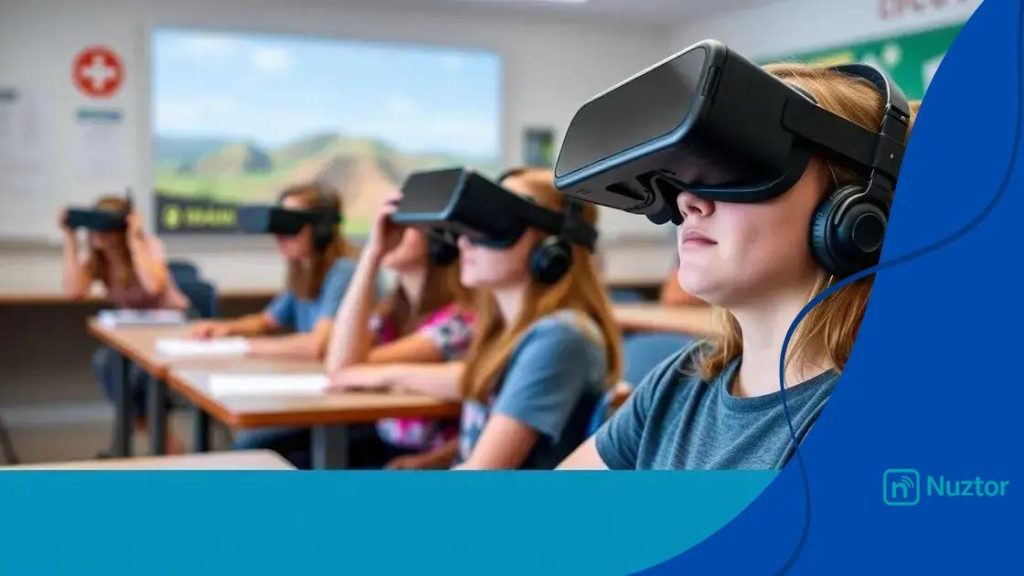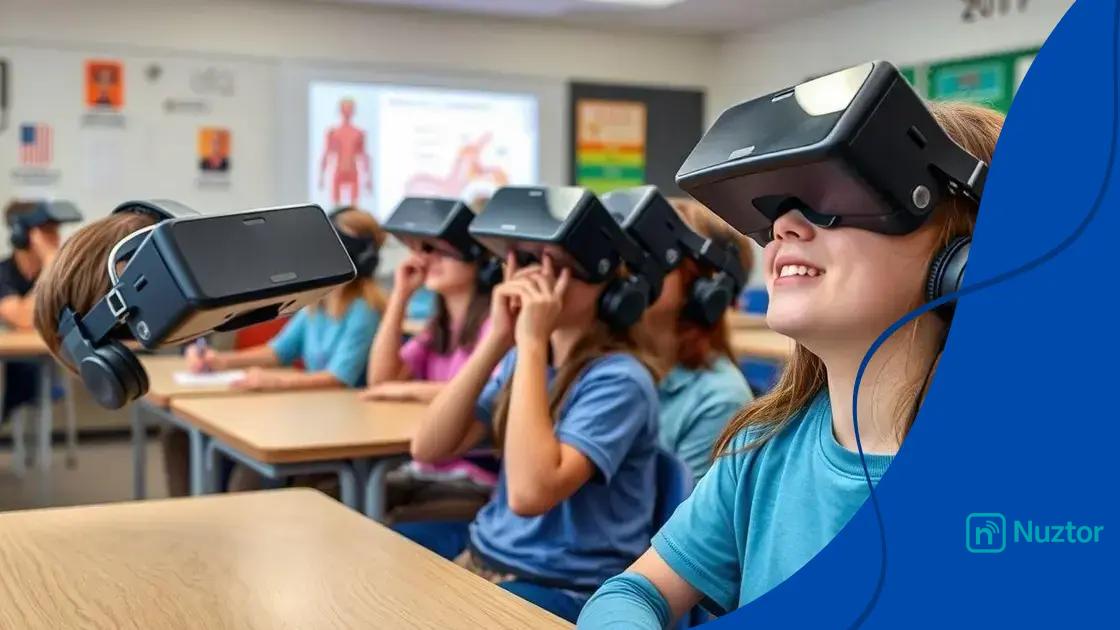Virtual reality in classrooms: transforming education

Virtual reality in classrooms enhances student engagement and understanding through immersive experiences, while facing challenges such as costs and technical issues, leading to promising future trends in education.
Virtual reality in classrooms can truly reshape the educational experience. Imagine students exploring ancient civilizations or diving into the depths of the ocean without leaving their seats! This technology offers exciting opportunities for deeper learning and engagement.
Understanding virtual reality in education
Understanding virtual reality in education is essential as technology continues to shape the learning environment. This immersive technology offers unique experiences that can make lessons more engaging and memorable for students.
What is virtual reality?
Virtual reality (VR) is a computer-generated environment where users can interact with 3D worlds. In education, VR allows students to explore concepts in ways that traditional methods cannot match. Imagine students walking through the solar system or diving into the ocean to study marine life.
Benefits of VR in classrooms
- Enhanced engagement: Students are more likely to pay attention and participate when using VR.
- Real-world applications: VR simulates real-life scenarios that can be applied to various subjects.
- Improved retention: Experiencing lessons in an immersive environment helps students remember information better.
- Accessibility: VR technology can create experiences that are not easily replicated in a traditional classroom.
Using VR in education not only supports traditional teaching methods but also enhances them. Students can connect with the material on a deeper level, sparking curiosity and encouraging further exploration. Additionally, teachers can customize experiences to meet the needs of diverse learners.
As educators learn more about the possibilities of VR, many are reimagining how lessons can be taught. By incorporating interactive elements and simulations, students can become active participants in their learning journey. This active involvement promotes critical thinking and problem-solving skills.
Furthermore, VR helps break down barriers. Students who may struggle with complex subjects can gain a clearer understanding through visual and interactive experiences. This technology can make learning accessible to all, catering to different learning styles.
In summary, understanding virtual reality in education is about recognizing its potential to transform the learning experience. It introduces innovative ways for students to engage with lessons, paving the way for a more exciting and effective education.
Benefits of virtual reality in classrooms
Understanding the benefits of virtual reality in classrooms can revolutionize the way students learn. This innovative technology engages students in interactive experiences that can enhance both comprehension and retention.
Increased Engagement
One major benefit is the increased engagement that VR provides. Students tend to be more motivated when they can explore immersive environments, like ancient cities or distant planets. This hands-on learning experience captures their attention and makes lessons more enjoyable.
Personalized Learning
Virtual reality allows educators to tailor experiences to meet individual student needs. With VR, teachers can create customized scenarios that cater to different learning styles, making it easier for students to grasp complex concepts.
- Visual learners: Benefit from seeing concepts in a 3D space.
- Auditory learners: Can engage with audio elements within the virtual environment.
- Kinesthetic learners: Gain hands-on experience through interaction.
Moreover, VR can help students who struggle with traditional teaching methods. For instance, a student with reading difficulties can better understand a story when they are immersed in a VR setting that literally brings the narrative to life.
Another significant advantage is the development of soft skills. Through role-playing and simulations in VR, students can improve their teamwork and communication skills. This is crucial as they prepare for real-world situations that require collaboration and effective interaction.
The cost-effectiveness of using VR in education is also noteworthy. Schools can offer field trips around the world without the associated travel expenses or logistical challenges. This makes learning more accessible, as it breaks physical barriers and provides opportunities that might otherwise be unavailable to students.
Practical applications of VR in learning

The practical applications of VR in learning are numerous and varied, significantly enhancing the educational experience. Virtual reality is being used in subjects like science, history, and even language learning, providing opportunities for immersive learning.
Science Education
In science classes, VR allows students to explore complex processes. For instance, they can view the human body in 3D, seeing how organs function and interact. This not only makes learning more interactive but also helps students visualize concepts that are often hard to grasp through textbooks.
Historical Exploration
Virtual reality can transport students back in time. Imagine walking through ancient Rome or witnessing key events in history. This makes lessons more engaging and memorable. Students are more likely to remember historical facts when they can actually “experience” them through VR.
- Historical reenactments: Provides students with a first-hand perspective of historical events.
- Exploring ancient civilizations: Enables students to visit reconstructed versions of lost cities.
- Interactive timelines: Helps visualize the sequence of historical events.
Language learning also benefits from VR technology. Students can practice speaking and comprehending a new language by engaging in simulated conversations with native speakers. This environment can boost their confidence as they learn to communicate effectively.
Moreover, VR can aid in developing important skills such as problem-solving and critical thinking. Through interactive scenarios, students are pushed to make decisions and see the outcomes of their choices. This real-time learning fosters a deeper understanding of the subject matter.
Skills-based training also finds its place in VR applications. For example, vocational students can practice tasks in a safe, controlled environment before working in real-world settings. This makes the learning process more practical and relevant for their future careers.
Challenges of implementing VR technology
There are several challenges of implementing VR technology in educational settings that schools and educators must navigate. While the benefits are substantial, obstacles can hinder the effective use of virtual reality in classrooms.
Cost and Accessibility
One primary challenge is the cost of VR equipment. High-quality headsets, software licenses, and updates can be expensive. Many schools, especially those in lower-income areas, may struggle to afford these technologies. This creates a gap in accessibility, limiting some students’ opportunities to benefit from VR.
Technical Issues
Another significant challenge is dealing with technical issues. VR software can be complex, and teachers need proper training to use it effectively. If educators don’t feel comfortable with the technology, they might avoid using it altogether. Technical glitches, compatibility problems, and other issues can disrupt lessons and frustrate both teachers and students.
- Maintenance: Regular maintenance is needed to keep VR systems running smoothly.
- Integration: VR must work with existing classroom technology, which can be a challenge.
- Updates: Keeping software and hardware updated can be time-consuming and costly.
Additionally, there are concerns about motion sickness and physical discomfort associated with VR use. Some students may experience nausea or headaches while using VR headsets, leading to a negative learning experience. Furthermore, educators must consider students’ varying comfort levels and adapt activities accordingly.
Lastly, effective content creation can pose a challenge. Not all subjects have readily available VR content, and creating custom VR experiences requires time, expertise, and resources. Teachers must often rely on third-party developers, which can lead to inconsistent quality in the learning material.
Future trends in virtual reality for schools
The future trends in virtual reality for schools are exciting and promise to change how education is delivered. As technology evolves, schools are finding new and innovative ways to integrate VR into their curriculums.
Enhanced Immersive Experiences
One trend is the development of more enhanced immersive experiences. As VR technology improves, students will be able to engage in even more realistic environments. Imagine being able to visit historic sites or explore the microscopic world directly from the classroom!
Collaboration and Social Learning
Another emerging trend is the focus on collaboration and social learning. Future VR applications may allow students from different locations to work together on projects in a shared virtual space. This could help build essential teamwork skills and allow students to learn from diverse perspectives.
- Virtual field trips: Students can travel the globe without leaving the classroom.
- Joint projects: Collaborative learning with VR will become more common.
- Teacher training: Educators will use VR simulations for professional development.
Moreover, personalized learning experiences will likely become the norm. With advancements in AI and VR, students may receive customized content based on their learning pace and style. This means each student could have a tailored educational journey, maximizing their understanding and retention of information.
Furthermore, as VR becomes more accessible, schools may adopt these technologies at a quicker pace. The increased availability of affordable VR tools will support widespread integration into classrooms. This could eventually lead to VR being a standard part of the education system.
Additionally, increased research and development in VR education tools will help create high-quality, curriculum-aligned experiences. Content developers will focus on creating engaging and educational VR programs, making it easier for educators to adopt and implement.
FAQ – Frequently Asked Questions about Virtual Reality in Education
What are the main benefits of using virtual reality in classrooms?
The main benefits include enhanced engagement, improved understanding of complex subjects, and opportunities for personalized learning.
What challenges do schools face when implementing VR technology?
Challenges include high costs, technical issues, and the need for proper training to effectively use VR tools.
How can virtual reality enhance science education?
VR allows students to visualize complex scientific processes and explore real-world applications in an interactive environment.
What future trends can we expect in virtual reality for education?
Future trends include more immersive experiences, greater collaboration through shared virtual spaces, and increased accessibility of affordable VR tools.